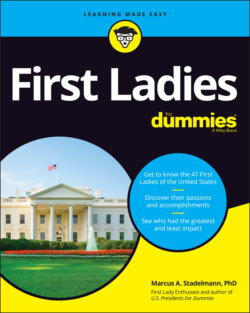Читать книгу First Ladies For Dummies - Marcus A. Stadelmann, Marcus A. Stadelmann PhD - Страница 22
Phase II (1829–1869)
ОглавлениеPhase II is dominated by young substitutes — either daughters, daughters-in-law, or nieces — for First Ladies. There were few mature or strong First Ladies during this period; most were youthful surrogates who didn’t impact policy making much. (Turn to Part 3 for a closer look at these ladies.)
Six out of nine first ladies during this time period pleaded ill health or grief as reasons for not being able to perform First Lady functions. They were Anna Harrison, Letitia Tyler, Margaret Taylor, Abigail Fillmore, Jane Pierce, and Eliza Johnson. Rachel Jackson had made arrangements for her niece to serve as First Lady in case she died, which she did. In some cases, there was no other way. Andrew Jackson’s wife passed right after he got elected president in 1828 and was unable to serve as First Lady. The same situation occurred in Martin Van Buren’s case. In both instances, younger nieces had to take over as First Lady.
Only two First Ladies were exceptions. Both Sarah Polk and Harriet Lane, the niece of President Buchanan who was a bachelor, were excited to become First Lady and were quite active. Not surprisingly, both are among my top ten most influential First Ladies (see Chapter 21).
